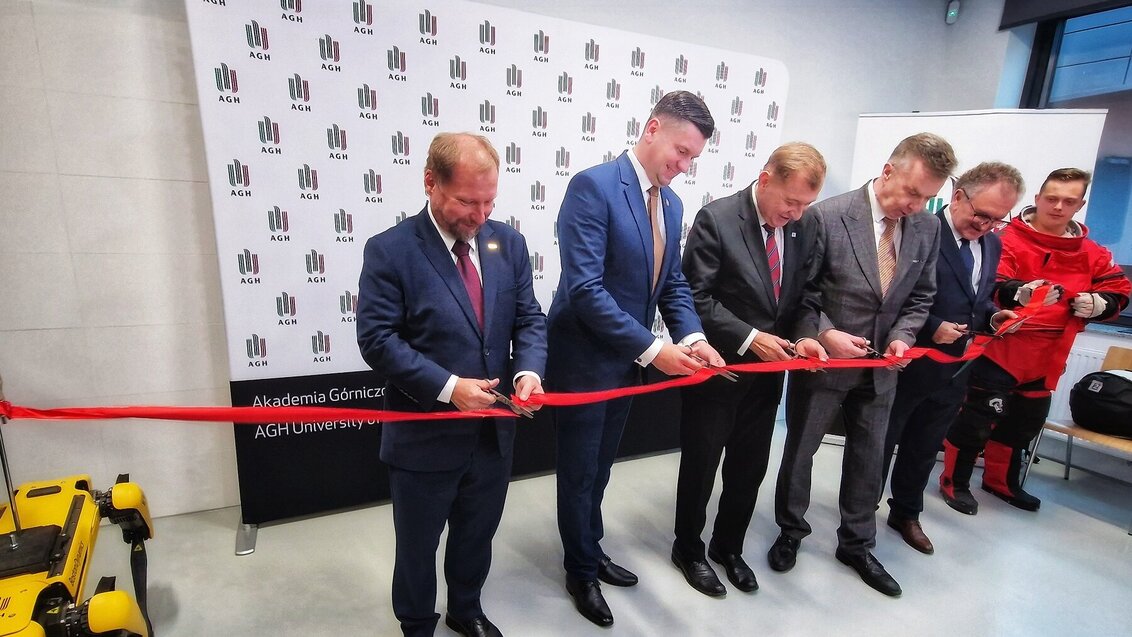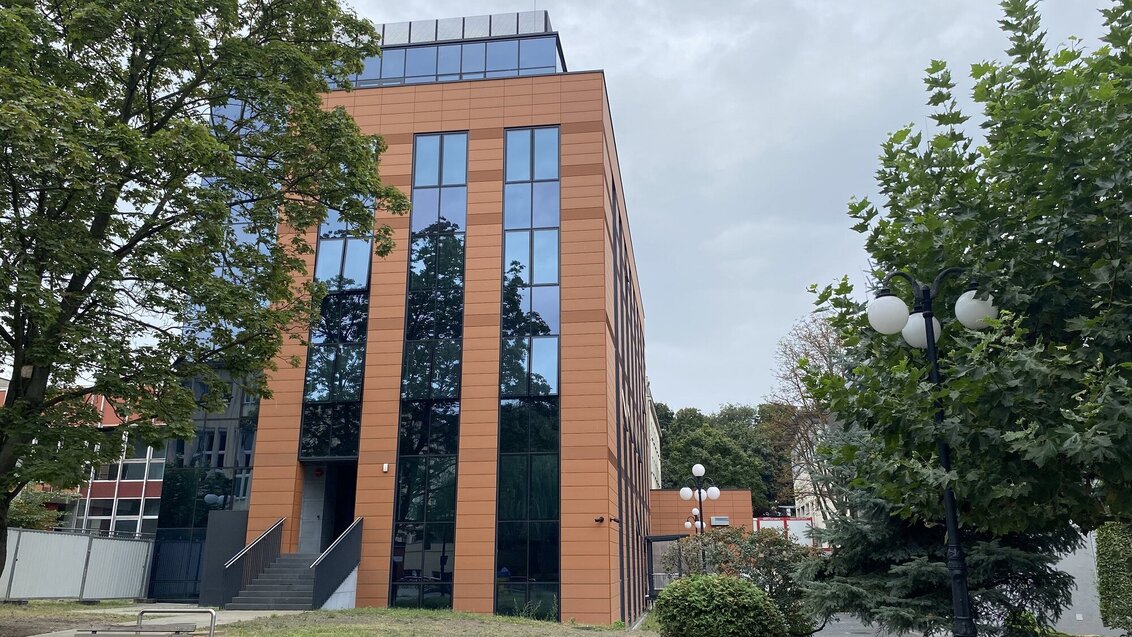
Photograph: Natalia Bujak
A new facility appeared on the map of the AGH University Campus. The building will be used by the Space Technology Centre and the Faculty of Mechanical Engineering and Robotics. It will be a place where students can refine their projects in space and mechatronic engineering.
The building is part of a complex that has been modernised since 2018.
“We are commissioning a facility that reflects our ongoing passion to explore and reach beyond the horizon. Research within space engineering is what gets us there. Space exploration begins on Earth, in laboratories and with teams such as those we have managed to gather here, at the Space Technology Centre, and during studies like mechatronic engineering provided at the Faculty of Mechanical Engineering and Robotics. It is here that our staff and students will run simulations of conditions on space stations and design and examine the properties of the latest materials used during space flights,” said AGH University Rector Jerzy Lis during the grand opening.
Mechatronic Engineering in a new seat
“In the new building, the Faculty of Mechanical Engineering and Robotics will, for example carry out research and provide education in the field of mechatronic engineering. Said tasks will be implemented by the Department of Robotics and Mechatronics, responsible for the field of study Mechatronic Engineering in Polish and in English, among many others. We are planning to create a classroom that will give students access to the latest technologies in robotics and mechatronics,” explained Professor Jarosław Konieczny, Dean of the Faculty of Mechanical Engineering and Robotics.
The laboratories will be part of the structure of the Department of Robotics and Mechatronics, which, in line with the university mission, conducts modern research and education activities aimed at supporting the economy in terms of innovation and high technology. The investment in new research and teaching infrastructure is a response to the rapid development of sectors including space, energy, and electromobility in Poland, which are on the list of priorities for economic development in Poland. Research is conducted in international cooperation with leading scientific entities from Europe, North America, Asia, and the Middle East. The new infrastructure will accommodate these relationships to be strengthened by intensifying academic exchange, the internationalisation of science in Poland, and joint research projects.
The list of faculty laboratories will include the following:
- laboratory of mobile robots and autonomous systems, co-created in cooperation with the Kraków-based technology company Husarion, equipped with the latest solutions in mobile robotics: autonomous platforms and walking robots. The laboratory's infrastructure allows platforms to be tested in a variety of conditions, from industrial halls to difficult terrain in military and space applications.
- laboratory of collaborative and cognitive industrial robots, co-created with Multiprojekt Automatics, equipped with the latest developments in robotics based on artificial intelligence. Test benches will enable research on and testing of state-of-the-art control algorithms, as well as the interaction of cognitive robots with the environment, industrial infrastructure, and humans.
- laboratory of structural dynamics and laser vibrometry, dedicated to the study of modern structures used, among others, in aviation, space, or defence industries.
- laboratory of new technologies for non-destructive testing and monitoring of the technical condition of structures, equipped with both proprietary solutions for damage detection and localisation systems, as well as state-of-the-art non-destructive testing equipment.
Base for space research
The intensive development of the AGH University in the area of space engineering, obtaining the title of the European Space University, and joining the UNIVERSEH project (European Space University for Earth and Humanity) resulted in the need to expand the infrastructure which will be used by employees and student teams conducting research within space engineering. The unit coordinating UNIVERSEH activities at the AGH University is the Space Technology Centre. In the new facility, the Centre will carry out research on, among others, the development of materials for space applications, implementation of satellite missions, astrobiology, and the development of equipment for the exploration of space resources.
A separate part of the building was created with the Space Technology Centre in mind to perform research on shock and vibration resistance of rockets and satellites. In the coming years, the new facility will be equipped with another special place. The habitat for analogue space missions will serve to train future astronauts and test technologies for space applications. The unique on-the-world-scale lab will soon make it possible to conduct experiments related to the presence of people in space.
One of the most unique laboratories in the new building will be a laboratory with a dirty thermal vacuum chamber, simulating the conditions on the lunar surface.
Moreover, the new seat of the Space Technology Centre will also include:
- the laboratory of space biology, where researchers will study the biological effect of space flights on living organisms;
- laboratory of space biomedical engineering intended for research on ageing processes in space and on Earth and disease prevention;
- laboratory of sensors for space use, used to develop advanced nanomaterials for sensors used in space-related applications;
- and laboratory of material research, where the research staff will investigate the properties of various materials under near-space conditions, including low and high temperatures.
Professor Tadeusz Uhl, Director of the AGH University Space Technology Centre, added:
"We are currently working to equip the laboratories where our staff is going to carry out research. Students who are active within space research clubs will also be provided with their own space in the new building, to work and develop their projects. At the new site, we will create conditions for work and research on people and equipment that will be sent to space.”
***
The construction cost of building D-3 along with the purchase of equipment amounted to PLN 40.2 million. The investment was financed from the university’s own funds.
Technical parameters of the building:
- Building area: 630 m2
- Usable floor area: 2,876 m2
- Total area: 3,456 m2
- Volume: 14,286 m3

 AGH University Alumni Day 2024
AGH University Alumni Day 2024  20 years of AGH University-SIT partnership and inauguration of Alumni Association in Tokio
20 years of AGH University-SIT partnership and inauguration of Alumni Association in Tokio  Projects by AGH University Main Library with funding from Scientific Social Responsibility programme
Projects by AGH University Main Library with funding from Scientific Social Responsibility programme  Honouring those we lost this year
Honouring those we lost this year  On energy transformation and more. Distributed Energy Congress
On energy transformation and more. Distributed Energy Congress  AGH University to establish AI Factory
AGH University to establish AI Factory 

